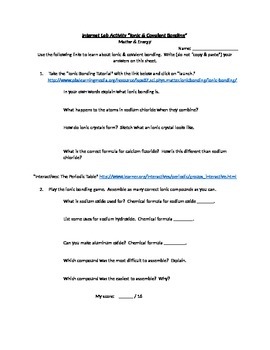Introduction to Chemistry Internet Activity “Ionic & Covalent Bonding”
- Word Document File
- Internet Activities
- Webquests
Description
This activity/review aligns with the Common Core State Standards:
STANDARD 5 - Matter and Energy
"The teacher understands the nature and properties of energy in its various forms, and the processes by which energy is exchanged and/or transformed.
5A. understands the atomic and nuclear structure of matter and the relationship to chemical and physical properties
5C. understands the cause and effect of chemical reactions in natural and manufactured systems
5F. explains conservation of mass and energy and explains interactions of energy with matter, including changes in state"
Student Internet activity and review of lessons I and II "Ionic and Covalent Bonding" in the Unit V Introductory Chemistry "Chemical Bonds" folder.
*All ActivInspire reviews; PowerPoint programs; student note guides/activities; labs and assessments can be found under the "Unit V Chemical Bonds" zip file folder.
Terms/concepts in this activity include:
valence electrons
chemical properties
energy levels
element reactivity
electron configuration
noble gases
stable electron configuration
electron dot diagrams
ionic bonds
ionic bonding
sodium chloride
ions
electron transfer
cations
anions
naming ions
chemical bonds
ionization energy
periodic table
Group 1A
ionic compounds
chemical formulas
writing formulas
crystals
crystal lattice
crystal systems
ionic compound properties
nonmetals
ionization energies
covalent bonding
diatomic elements
halogens
noble gases
electron dot model
structural formula
multiple covalent bonds
double bonds
triple bonds
electron attraction
molecule shape
molecular compounds
methane
water
astronomydad
Introduction to Chemistry Internet Activity “Ionic & Covalent Bonding” by astronomydad is licensed under a Creative Commons Attribution 4.0 International License.





